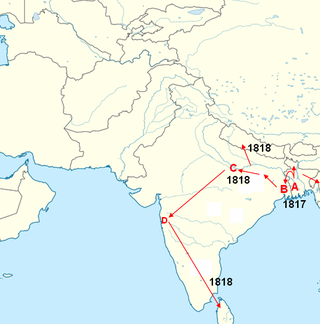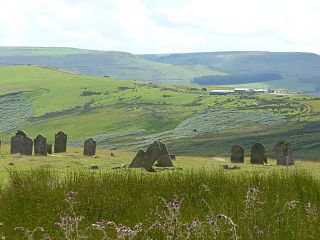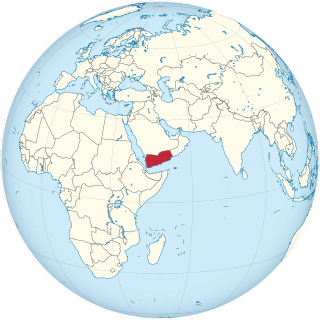Related Research Articles

Abraham Stoker was an Irish author who wrote the 1897 Gothic horror novel Dracula. During his lifetime, he was better known as the personal assistant of actor Sir Henry Irving and business manager of the West End's Lyceum Theatre, which Irving owned.

Cholera is an infection of the small intestine by some strains of the bacterium Vibrio cholerae. Symptoms may range from none, to mild, to severe. The classic symptom is large amounts of watery diarrhea lasting a few days. Vomiting and muscle cramps may also occur. Diarrhea can be so severe that it leads within hours to severe dehydration and electrolyte imbalance. This may result in sunken eyes, cold skin, decreased skin elasticity, and wrinkling of the hands and feet. Dehydration can cause the skin to turn bluish. Symptoms start two hours to five days after exposure.

A quarantine is a restriction on the movement of people, animals and goods which is intended to prevent the spread of disease or pests. It is often used in connection to disease and illness, preventing the movement of those who may have been exposed to a communicable disease, yet do not have a confirmed medical diagnosis. It is distinct from medical isolation, in which those confirmed to be infected with a communicable disease are isolated from the healthy population. Quarantine considerations are often one aspect of border control.

A cordon sanitaire is the restriction of movement of people into or out of a defined geographic area, such as a community, region, or country. The term originally denoted a barrier used to stop the spread of infectious diseases. The term is also often used metaphorically, in English, to refer to attempts to prevent the spread of an ideology deemed unwanted or dangerous, such as the containment policy adopted by George F. Kennan against the Soviet Union.

Cholera riots are civil disturbances associated with an outbreak or epidemic of cholera.

The first cholera pandemic (1817–1824), also known as the first Asiatic cholera pandemic or Asiatic cholera, began near the city of Calcutta and spread throughout South Asia and Southeast Asia to the Middle East, Eastern Africa and the Mediterranean coast. While cholera had spread across India many times previously, this outbreak went further; it reached as far as China and the Mediterranean Sea before subsiding. Millions of people died as a result of this pandemic, including many British soldiers, which attracted European attention. This was the first of several cholera pandemics to sweep through Asia and Europe during the 19th and 20th centuries. This first pandemic spread over an unprecedented range of territory, affecting almost every country in Asia.
The second cholera pandemic (1826–1837), also known as the Asiatic cholera pandemic, was a cholera pandemic that reached from India across Western Asia to Europe, Great Britain, and the Americas, as well as east to China and Japan. Cholera caused more deaths, more quickly, than any other epidemic disease in the 19th century. The medical community now believes cholera to be exclusively a human disease, spread through many means of travel during the time, and transmitted through warm fecal-contaminated river waters and contaminated foods. During the second pandemic, the scientific community varied in its beliefs about the causes of cholera.

The third cholera pandemic (1846–1860) was the third major outbreak of cholera originating in India in the 19th century that reached far beyond its borders, which researchers at University of California, Los Angeles (UCLA) believe may have started as early as 1837 and lasted until 1863. In the Russian Empire, more than one million people died of cholera. In 1853–1854, the epidemic in London claimed over 10,000 lives, and there were 23,000 deaths for all of Great Britain. This pandemic was considered to have the highest fatalities of the 19th-century epidemics.

The fifth cholera pandemic (1881–1896) was the fifth major international outbreak of cholera in the 19th century. The endemic origin of the pandemic, as had its predecessors, was in the Ganges Delta in West Bengal. While the Vibrio cholerae bacteria had not been able to spread to western Europe until the 19th century, faster and improved modes of modern transportation, such as steamships and railways, reduced the duration of the journey considerably and facilitated the transmission of cholera and other infectious diseases. During the fourth 1863–1875 cholera pandemic, the third International Sanitary Conference convened in 1866 in Constantinople had identified religious pilgrimages to be "the most powerful of all causes" of cholera and again Hindu and Muslim pilgrimages were an important factor in the spread of the disease.

The seventh cholera pandemic is the seventh major outbreak of cholera and occurred principally from the years 1961 to 1975, but the strain involved persists to the present. WHO and some other authorities believe this should be considered as an ongoing pandemic. As stated in its cholera factsheet dated 30 March 2022, the World Health Organization (WHO) continues to define this outbreak as a current pandemic, and with cholera having become endemic in many countries. In 2017, WHO announced a global strategy aiming to end this pandemic by 2030.

The Broad Street cholera outbreak was a severe outbreak of cholera that occurred in 1854 near Broad Street in Soho, London, England, and occurred during the 1846–1860 cholera pandemic happening worldwide. This outbreak, which killed 616 people, is best known for the physician John Snow's study of its causes and his hypothesis that germ-contaminated water was the source of cholera, rather than particles in the air. This discovery came to influence public health and the construction of improved sanitation facilities beginning in the mid-19th century. Later, the term "focus of infection" started to be used to describe sites, such as the Broad Street pump, in which conditions are favourable for transmission of an infection. Snow's endeavour to find the cause of the transmission of cholera caused him to unknowingly create a double-blind experiment.

Sir William Thornley Stoker, 1st Baronet, was an Irish medical writer, anatomist and surgeon. He served as chair of anatomy and president of the Royal College of Surgeons in Ireland, president of the Royal Academy of Medicine in Ireland, and professor of anatomy at the Royal Hibernian Academy.

Cefn Golau is a disused cholera cemetery situated on a narrow mountain ridge in the county borough of Blaenau Gwent, and located between Rhymney and Tredegar in south-east Wales. A suburb of Tredegar and a nearby feeder reservoir have the same name. The graves date from 1832 to 1855 with many for August and September 1849.

Seven cholera pandemics have occurred in the past 200 years, with the first pandemic originating in India in 1817. The seventh cholera pandemic is officially a current pandemic and has been ongoing since 1961, according to a World Health Organization factsheet in March 2022. Additionally, there have been many documented major local cholera outbreaks, such as a 1991–1994 outbreak in South America and, more recently, the 2016–2021 Yemen cholera outbreak.
The typhus epidemic of 1847 was an outbreak of epidemic typhus caused by a massive Irish emigration in 1847, during the Great Famine, aboard crowded and disease-ridden "coffin ships".

Diseases and epidemics of the 19th century included long-standing epidemic threats such as smallpox, typhus, yellow fever, and scarlet fever. In addition, cholera emerged as an epidemic threat and spread worldwide in six pandemics in the nineteenth century.

An outbreak of cholera began in Yemen in October 2016. The outbreak peaked in 2017 with over 2,000 reported deaths in that year alone. In 2017 and 2019, war-torn Yemen accounted for 84% and 93% of all cholera cases in the world, with children constituting the majority of reported cases. As of November 2021, there have been more than 2.5 million cases reported, and more than 4,000 people have died in the Yemen cholera outbreak, which the United Nations deemed the worst humanitarian crisis in the world at that time. However, the outbreak has substantially decreased by 2021, with a successful vaccination program implemented and only 5,676 suspected cases with two deaths reported between January 1 and March 6 of 2021.

The 1813–1814 Malta plague epidemic was the last major outbreak of plague on the islands of Malta and Gozo. It occurred between March 1813 and January 1814 on Malta and between February and May 1814 on Gozo, and the epidemic was officially declared to be over in September 1814. It resulted in approximately 4500 deaths, which was about 5% of the islands' population.
The cholera epidemics in Spain were a series of morbid cholera outbreaks that occurred from the first third of the 19th century until the end of the same century in the large cities of Spain. In total, some 800,000 people died during the four pandemics that occurred in Spain during that century. However, cholera was one of several contagious diseases that struck the country. Suffice it to say that the Spanish population in 1800 was 11.5 million people and was characterized by a high birth and death rate. The successive pandemics that the country suffered caused an economic recession, as well as an opportunity for profound change in health and hygiene in Spain. It was not free of controversy, both for the use of the vaccines created by Jaime Ferrán y Clúa and for the ways of combating the disease, as well as for the policies used to deal with it. It is worth mentioning that the terror caused in the population, due to the deaths caused, was the cause of popular revolts and social instability.
References
- 1 2 "Terror gripped Sligo as cholera epidemic raged through the town - Independent.ie". Sligo Champion. Retrieved 26 June 2018.
- ↑ Biles, Dede (31 July 2020). "'Life Under Lockdown' highlights similarities between 1832 cholera outbreak, coronavirus pandemic". Post and Courier. Retrieved 17 June 2021.
- 1 2 "Cholera". History. Retrieved 18 April 2019.
- ↑ Fenning, Hugh (2003). "The Cholera Epidemic in Ireland, 1832-3: Priests, Ministers, Doctors". Archivium Hibernicum. 57: 77–125. doi:10.2307/25484205. JSTOR 25484205 . Retrieved 24 May 2023.
- ↑ Faherty, Anna (6 July 2017). "The colonist who faced the blue terror". Welcome Collection. Retrieved 23 April 2023.
- 1 2 3 4 Wood-Martin, William Gregory (1889). History of Sligo Volume II. Hodges Figgis & Company.
- ↑ McGarry, Marion (20 May 2020). "Life under lockdown: the 1832 cholera epidemic" . Retrieved 24 May 2023.
- 1 2 3 McGarry, Marion (24 July 2020). "Podcast: Bram Stoker and the Cholera Epidemic of 1832" . Retrieved 24 May 2023.
- ↑ "December 21st 2007". SligoHeritage. Retrieved 18 April 2019.
- ↑ Meagher, John (21 April 2012). "The Sligo epidemic that stoked Bram's interest in all things". Irish Independent. Retrieved 4 October 2020.